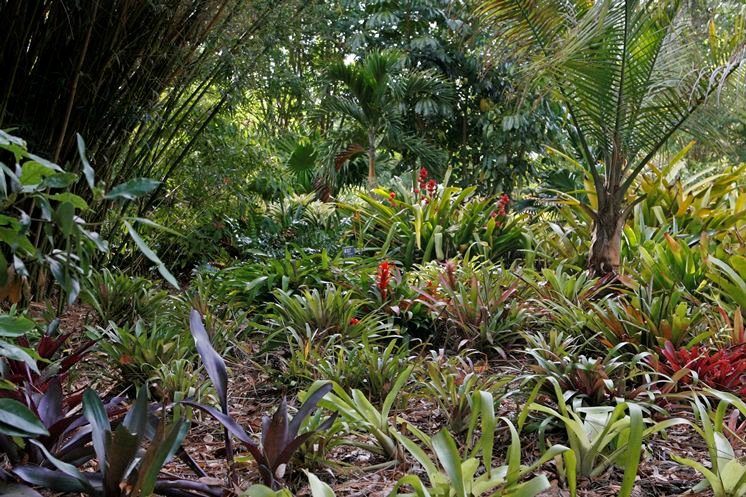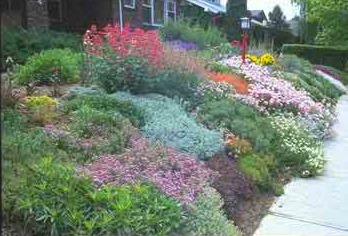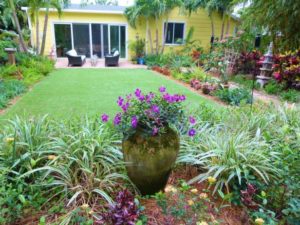
Xeriscaping is a philosophy originally conceived by Denver Water and consists of designing your landscaping scheme with drought tolerant, slower growing plants to promote water conservation. By doing this you reduce the resources needed to manage the landscaping while keeping it beautiful all year around. It also allows you to plan the aspects so that maintenance is lower and you spend more time enjoying your garden and landscaping and less time working on it. The methods used vary but follow certain basic principles:
- Using Drought Resistant Plants
- Using Zones of Planting
- Using the Right Plant in the Right Place
- Mulch and Soil Amendments
- Drought Tolerant Turf
We’re not going to go into the turf issue. That is a whole world of debate unto itself. Landscapers in your area that follow the State of Florida’s Best Management Practices (BMP) will be able to tell you what turf type is best for your property and which will be best for xeriscaping much better than we could here.
Xeriscaping can be done through the use of indigenous Florida plants that naturally thrive in the soil type and environmental conditions of the area. Or it can be the use of other non-native plants that also thrive in Florida conditions but use less water. The advantage to the use of Florida native plants is that you will know the growth rate, requirements, and expectations of the plants better. Being native, they will have far fewer surprises than non-native species but either can be used to xeriscape.

Another benefit from native plants is that they will attractive native wildlife. The bees, butterflies, and hummingbirds of Florida will be attracted to native flowering species because they will instinctively recognize them. This can be helpful if you have any fruit bearing plants or a garden because these are the primary pollinators. The more bees and butterflies that come to your flowers, the more blooms will be pollinated and the more fruit and vegetables your plants will yield. Bees and butterflies tend to follow a route to find nectar so if your property has flowering plants they recognize, they will make a habit of paying you a visit on their daily rounds and if there are other flowering plants such as the fruit trees there, so much the better, they’ll visit them too. If you normally do not have flowering plants on a regular basis you’ll be less likely to get a visit for the flowering period of your fruit trees and vegetables.
When considering a landscaping design you can create zones of plants. If some of the plants that you like require more maintenance or require more resources, you can group them together and xeriscape other areas for worry free zones of landscaping. In this way, you reduce the amount of resources required as a whole, while still getting all the types of plants you want. You only need to water those specific areas more while the rest will take care of itself. There is no limit to the combinations of zones; it all depends on what you’d like to have and how much time you’d like to spend working on it. Separating the plants into zones makes sure each area gets the resources and care it needs to thrive.
Using mulch and soil amendments is another key portion of xeriscaping. Mulch is not only decoration; it also helps resist evaporation and erosion, and prevents the growth of weeds. As the mulch naturally composts it will add nutrients to the soil and help the soil retain water through amendment (the bits of wood help hold onto water as they break down into soil). Adding another layer of mulch on top makes the entire area look brand new again. Using water retention additives can help, especially in the sandy Florida soil, with aeriation of the soil as well as water management. Keeping the soil from compacting can help ensure the plants can grow well established root structures that will allow them to survive without having to be fertilized more than once a year in the spring time.

A big benefit of xeriscaping for seasonal residents is that because the plants are slower growing, you can leave them during the summer months without returning to your home to find a jungle growing out back or, even worse, a yard full of dead plants you need to replant. The xeriscaping requires less maintenance and will thrive without constant monitoring. You’ll come back to a beautiful garden just like when you left. Many of the native species will flower all year long so that you have a constantly stunning garden. Other species provide a constant ground cover even during the dry winter months and are hardy enough to face off any cold that may come. We don’t freeze here often but if you rely on too many tropical species, you’ll end up replanting your whole yard each time a cold snap hits.
It is also easier to create an overall outdoor design plan with xeriscaping. Because you know the size of the plants and they are slow enough growing that you will not get huge spurts of growth over the summer months, you can plan your landscaping, gardens, lighting, and other fixtures knowing that the plant life will not overwhelm everything else. That gives you the freedom to create a more permanent design that integrates all the features without having to be constantly readjusted. When you draw up your plan you can choose what species need full sun and what can do with a bit of shade. Choosing species that can survive the harsh Florida summer sun will ensure that you don’t come back to withered and dead plants in the fall.

In Florida, we sometimes get amazingly great amounts of rain in a short period of time. The design of xeriscaping helps prevent runoff from this. The mulch and soil additives used to help with water conservation will also help prevent the soil from being washed away. Plants that are drought resistant also tend to have well established root structures which in turn help with soil erosion. While nothing will stop damage from a severe flood, xeriscaping can help mitigate runoff from torrential downpours.
The state of Florida has some excellent information online about xeriscaping:
http://fyn.ifas.ufl.edu/index.html
They provide information about plant species, methods, and BMP for home owners, property managers, and professionals.
[sgmb id=”1″ customimageurl=”” ]

